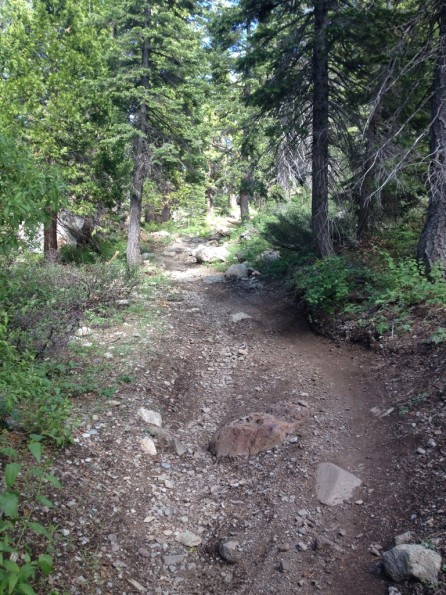
For many years, mountain biking in the Lost Sierra region of California was anchored in the town of Downieville. Downieville was put on the map by the epic Downieville Downhill shuttle run, and popularized by the Downieville Classic race and festival. Now, the radius of mountain bike opportunities is expanding dramatically to encompass the entire Lost Sierra, with recent trail development taking place on the opposite side of the Pacific Crest Trail near the towns of Quincy and Graeagle.
In fact, this focus shift from the Sierra Buttes Trail Stewardship (SBTS) is so dramatic that they’ve closed the iconic Yuba Expeditions bike shop and shuttle service in Downieville to focus solely on their establishment in the town of Quincy, an hour and fifteen minutes away by car.
But when you learn what SBTS is working on in Quincy, it will all start to make sense.
In short, the SBTS is wrapping up a 38-mile expansion to the Mt. Hough trail system, bringing the total trail mileage on the mountain rising above downtown Quincy to 70 miles of bike- and moto-legal singletrack.
Mt. Hough Phase I was already epic, but it’s getting even better.
Before construction began on Phase II of the trail development, Mt. Hough was already home to over 30 miles of singletrack, including an epic 12-mile top-to-bottom shuttle run dropping about 4,200 vertical feet with less than 400 feet of climbing required.
When I visited the Lost Sierra in 2020, I was focused on exploring the trails around Downieville and Graeagle. As I posted photo updates on Instagram, multiple people came out of the woodwork to say that I had to ride Mt. Hough. This was the rare case of social media actually proving useful, as I shifted my plans and drove over an hour away from my base of operations to fit in a Mt. Hough shuttle.
And it was epic!
The original descent is a flowy, intermediate-friendly trail largely bereft of technical features, save for one spicy alt line at the summit. Even still, swooping and flowing through the pines while dropping over 4,000ft of vert in this remote corner of the Sierras is just downright fun, and it has the added bonus of ending at a shockingly-cold swimming hole — perfect for 90-degree mid-summer days.

Two more top-to-bottom runs coming in Phase II
This 38-mile expansion will add two additional top-to-bottom runs on the mountain — hence why Yuba is investing in their shuttle operations in Quincy. “Having that variety for people, having two more options to go top to bottom is really cool, and we utilize more of the mountain,” said Nicole Formosa, Marketing and Communications Manager for SBTS.
These new trails will also add a variety of trail quality and character. “Topography-wise, the Indian Falls Ridge Trail looks really different than the Hough trail. [It’s] rockier over on that side,” said Formosa. However, riders shouldn’t expect dedicated downhill runs or jump trails, as all of these trails are still built to accommodate two-way traffic, including motos.
While there will soon be three top-to-bottom runs, there are already more trails on the lower mountain, which provide a few different options for ending runs. This is where the rest of the trail mileage comes from.
Finally, one of the most exciting parts of this phase of development is the completion of a 13-mile singletrack connection from Quincy to Taylorsville. According to Formosa, it’s notable as “the first connector of the Connected Communities project.” This will be “the first [singletrack] connection between two communities” in the Lost Sierra.
And it’s all e-bike legal
All the trails built on Mt. Hough, located in the Plumas National Forest, are open to motorized travel. In fact, “Mt. Hough has historically largely been supported by OHV dollars,” according to Formosa. “So California OHV green tag funding has largely been the grant that has paid for Hough.”
The total anticipated project cost for Phase II is $1,425,875 and at least $932,265 has already been raised. The vast majority of the funding acquired thus far has come from OHV funds, along with a private donation from the Negley Flinn Foundation. However, that $923K number “doesn’t include matching requirements for the OHV grants and other indirect costs that are expected to bring that number closer to the projected $1.42 million when it’s finished in 2025,” according to Formosa.
The Mt. Hough funding also includes “$157,370 in annual project maintenance costs for the Hough trails that will be a recurring cost each year,” said Formosa. “All of that will be paid for through a combination of the OHV grants, private donations (like Negley Flinn), and fundraisers (like our 5 Bikes a Foot fundraisers).”
The fact that these trails are all moto-legal means, by extension, that they’re all open to e-bikes. If you want a place to rip up the mountain on your e-bike and to access fast, flowy descents, put Mt. Hough on your list for your next road trip.
Despite the trails being moto-legal, Formosa says that they aren’t overrun by dirt bikes. “Yeah, you see some motos, you hear some motos. But there’s just so much out there,” said Formosa. “I mean, definitely motos ride it for sure. But in terms of trail conflict, it just does not even seem to be a thing.”
Most of the trails are already complete.
As of the time of this writing, 29 miles of the 38 planned in Phase II are already complete, with the remaining nine to be finished by the end of 2025. As noted above, once complete, the Mt. Hough trail system will boast an impressive 70 miles of singletrack, with three distinct top-to-bottom runs and singletrack connecting the communities of Quincy and Taylorsville.
It’s a great time to be a mountain biker in the Lost Sierra, and it’s only going to keep getting better!





















1 Comments
Oct 3, 2024